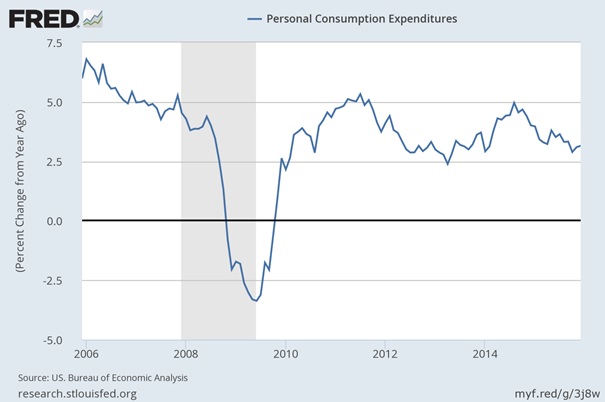Gold Rises On Weak Economic Data
Yesterday, gold hit a 3-month high on weak economic data. What does it mean for the US economy and the gold market?
U.S. Manufacturing Is Contracting
First, the Institute for Supply Management’s manufacturing index edged up from 48.0 to 48.2, but it remained below 50 in January, which indicates that more companies were shrinking than expanding. The index has been below 50 percent since October. It is the longest period of contraction since the last recession in 2009. Importantly, the Employment Index registered 45.9 percent, 2.1 percentage points lower than the December reading of 48 percent. So much for a strong labor market. Moreover, only eight of the 18 industries tracked by the ISM reported growth last month. The only positive thing in the report is new orders, as the New Orders Index registered 51.5 percent, an increase from 48.8 percent in December. But on balance, the report is a downbeat opening to 2016, which follows an awful year for the factory sector. Indeed, as one can see in the chart below, manufacturing has been declining throughout 2015 due to a strong U.S. dollar, weak global demand and the burst of the oil boom.
Chart 1: ISM Manufacturing Index from 2006 to 2016.

U.S. Consumer Spending Flat in December
Personal consumption expenditures were flat in December (they decreased less than 0.1 percent). The flat spending was partially offset by stronger November spending than the government initially reported. Importantly, American consumers purchased fewer new cars and trucks last month, which indicates that the automotive boom has reached its peak. Although consumer spending grew 3.4 percent in 2015, personal outlays were softer in the last quarter than in the prior two quarters. Actually, as one can see in the chart below, the growth of personal consumption expenditures has been slowing down since August 2014.
Chart 2: Personal Consumption Expenditures (percent change from a year ago) from 2006 to 2015.

U.S. Inflation Remains Low
The PCE price index decreased 0.1 percent in December, following an increase of 0.1 percent in November. The core PCE price index, which excludes food and energy, was flat in December (it increased less than 0.1 percent), compared to a rise of 0.2 percent in November. On an annual basis, the PCE index increased 0.6 percent (the highest 12-month pace in a year), while the core PCE index climbed 1.4 percent, the same pace as in November. Although we expect more deflationary pressure in the nearest future, coming especially from China, the chart below shows that both indices have been rising since October 2015 on an annual basis. However, there is still a long way for inflation to reach the desired 2-percent target.
Chart 3: PCE Price Index (blue line) and Core PCE Price index (red line) from 2006 to 2015 (as percent change from a year ago).
Chinese Manufacturing Sector Downturn Extends into 2016
China's manufacturing extended its long slump. The Caixin China General Manufacturing PMI Index edged up from 48.2 in December to 48.4 in January, but it remained below 50, which is a value separating growth from contraction. The Chinese factory sector has contracted for the eleventh successive month. It does not look like a soft landing.
Conclusions
The bottom line is that February started with weak data, both in the US and China. The disappointing news helped gold get above the $1,120 level. The US manufacturing remains in recession, consumer spending is slowing down and inflation is still low. The Chinese economy is decelerating, which reduces the global demand. The elevated worries about the state of the US economy and the reduced odds for the Fed hikes in 2016 are fundamentally bullish for the price of gold.



















